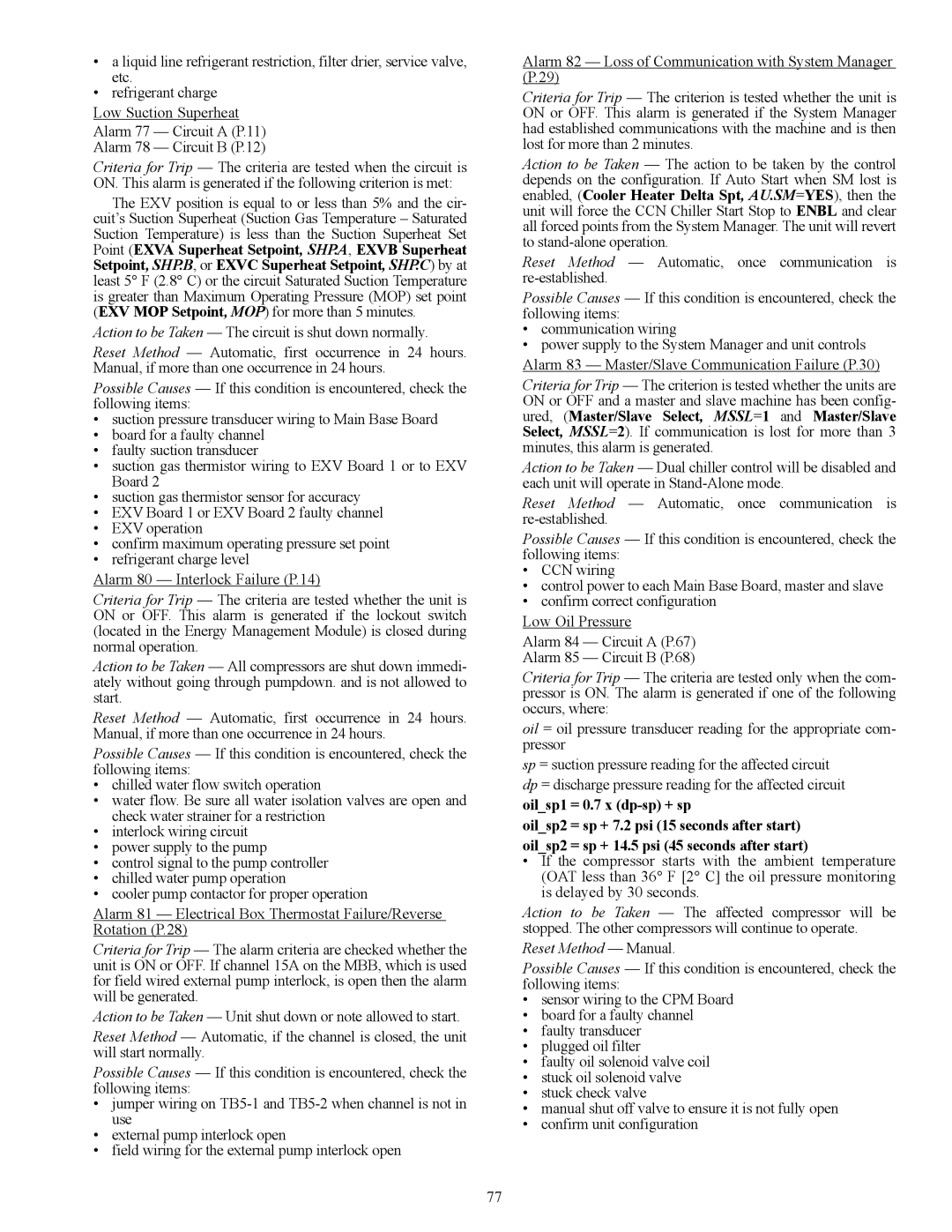•a liquid line refrigerant restriction, filter drier, service valve, etc.
•refrigerant charge
Low Suction Superheat
Alarm 77 — Circuit A (P.11)
Alarm 78 — Circuit B (P.12)
Criteria for Trip — The criteria are tested when the circuit is ON. This alarm is generated if the following criterion is met:
The EXV position is equal to or less than 5% and the cir- cuit’s Suction Superheat (Suction Gas Temperature – Saturated Suction Temperature) is less than the Suction Superheat Set Point (EXVA Superheat Setpoint, SHP.A, EXVB Superheat Setpoint, SHP.B, or EXVC Superheat Setpoint, SHP.C) by at least 5° F (2.8° C) or the circuit Saturated Suction Temperature is greater than Maximum Operating Pressure (MOP) set point (EXV MOP Setpoint, MOP) for more than 5 minutes.
Action to be Taken — The circuit is shut down normally.
Reset Method — Automatic, first occurrence in 24 hours. Manual, if more than one occurrence in 24 hours.
Possible Causes — If this condition is encountered, check the following items:
•suction pressure transducer wiring to Main Base Board
•board for a faulty channel
•faulty suction transducer
•suction gas thermistor wiring to EXV Board 1 or to EXV Board 2
•suction gas thermistor sensor for accuracy
•EXV Board 1 or EXV Board 2 faulty channel
•EXV operation
•confirm maximum operating pressure set point
•refrigerant charge level
Alarm 80 — Interlock Failure (P.14)
Criteria for Trip — The criteria are tested whether the unit is ON or OFF. This alarm is generated if the lockout switch (located in the Energy Management Module) is closed during normal operation.
Action to be Taken — All compressors are shut down immedi- ately without going through pumpdown. and is not allowed to start.
Reset Method — Automatic, first occurrence in 24 hours. Manual, if more than one occurrence in 24 hours.
Possible Causes — If this condition is encountered, check the following items:
•chilled water flow switch operation
•water flow. Be sure all water isolation valves are open and check water strainer for a restriction
•interlock wiring circuit
•power supply to the pump
•control signal to the pump controller
•chilled water pump operation
•cooler pump contactor for proper operation
Alarm 81 — Electrical Box Thermostat Failure/Reverse Rotation (P.28)
Criteria for Trip — The alarm criteria are checked whether the unit is ON or OFF. If channel 15A on the MBB, which is used for field wired external pump interlock, is open then the alarm will be generated.
Action to be Taken — Unit shut down or note allowed to start. Reset Method — Automatic, if the channel is closed, the unit will start normally.
Possible Causes — If this condition is encountered, check the following items:
•jumper wiring on TB5-1 and TB5-2 when channel is not in use
•external pump interlock open
•field wiring for the external pump interlock open
Alarm 82 — Loss of Communication with System Manager (P.29)
Criteria for Trip — The criterion is tested whether the unit is ON or OFF. This alarm is generated if the System Manager had established communications with the machine and is then lost for more than 2 minutes.
Action to be Taken — The action to be taken by the control depends on the configuration. If Auto Start when SM lost is enabled, (Cooler Heater Delta Spt, AU.SM=YES), then the unit will force the CCN Chiller Start Stop to ENBL and clear all forced points from the System Manager. The unit will revert to stand-alone operation.
Reset Method — Automatic, once communication is re-established.
Possible Causes — If this condition is encountered, check the following items:
•communication wiring
•power supply to the System Manager and unit controls
Alarm 83 — Master/Slave Communication Failure (P.30)
Criteria for Trip — The criterion is tested whether the units are ON or OFF and a master and slave machine has been config- ured, (Master/Slave Select, MSSL=1 and Master/Slave Select, MSSL=2). If communication is lost for more than 3 minutes, this alarm is generated.
Action to be Taken — Dual chiller control will be disabled and each unit will operate in Stand-Alone mode.
Reset Method — Automatic, once communication is re-established.
Possible Causes — If this condition is encountered, check the following items:
•CCN wiring
•control power to each Main Base Board, master and slave
•confirm correct configuration
Low Oil Pressure
Alarm 84 — Circuit A (P.67)
Alarm 85 — Circuit B (P.68)
Criteria for Trip — The criteria are tested only when the com- pressor is ON. The alarm is generated if one of the following occurs, where:
oil = oil pressure transducer reading for the appropriate com- pressor
sp = suction pressure reading for the affected circuit dp = discharge pressure reading for the affected circuit
oil_sp1 = 0.7 x (dp-sp) + sp
oil_sp2 = sp + 7.2 psi (15 seconds after start) oil_sp2 = sp + 14.5 psi (45 seconds after start)
•If the compressor starts with the ambient temperature (OAT less than 36° F [2° C] the oil pressure monitoring is delayed by 30 seconds.
Action to be Taken — The affected compressor will be stopped. The other compressors will continue to operate.
Reset Method — Manual.
Possible Causes — If this condition is encountered, check the following items:
•sensor wiring to the CPM Board
•board for a faulty channel
•faulty transducer
•plugged oil filter
•faulty oil solenoid valve coil
•stuck oil solenoid valve
•stuck check valve
•manual shut off valve to ensure it is not fully open
•confirm unit configuration
